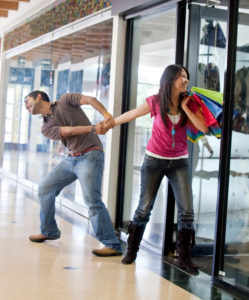As millennials, we often feel pressured by both the media and our peers to look and act a certain way. It’s a general rule of thumb that if you’re in your twenties or thirties, you’ll feel the strain of wanting the newest and best something at least once. Many of us will crack under pressure and eventually purchase that new iPhone (even though our current one works fine), or that new pair of jeans (even though we already have a pair in that colour).
The thing about succumbing to these societal pressures, though, is that for the most part, at the end of the day, we don’t feel better about ourselves after making these big purchases. In fact, a lot of the time, it’s quite the opposite. We see the shiny new product and our first reaction is “I need this now.” We can convince ourselves the price is irrelevant, and that it will pay for itself, or that it’s a necessity. But how frequently is that true? Do we ever really need to bow to those pressures?
Stop, Drop, Don’t Shop

It seems there is a trend emerging in the financial millennial blogosphere wherein bloggers enact a “shopping ban.” The terms of the bans vary by site, but the general premise remains the same: a new consumption philosophy rooted largely in the theory of not purchasing anything.
“Mrs. Frugalwoods” of the blog Frugalwoods, for instance, is well on her way to going three years clothes-purchasing-free. The site is devoted to financial independence and simple living and her current blog on this topic covers some important information on why she started the ban and why she’s continuing it to this day. It’s interesting to note that she managed to stick with her ban through an entire pregnancy. That’s right: she didn’t purchase any new maternity clothes. Even after “Babywoods” was born, the shopping ban continued, as Babywoods is being clothed in hand-me-downs and secondhand finds almost exclusively. Seriously commendable!

Cait Flanders (aka Twitter’s @blondeonabudget) has just come to the end of her second year shopping ban as well. She has yet to post her findings, as the deadline was just hit earlier this week, but in the meantime there’s plenty to read up on from her. There are several differences between Cait’s and Mrs. Frugalwoods’ shopping bans (Mrs. FW’s ban is all-encompassing, whereas Cait has given herself an “approved items” list). Even so, both missions give us some useful insight into the far-reaching impacts the garment industry has on every aspect of our lives.
Though these ladies began their bans as a way to simplify their lives and save money, both have had their eyes opened to some other unforeseen benefits of no-clothes-shopping. In addition to streamlining our lives and saving money, thinking twice about what we choose to purchase will have an immense impact not only on our lives, but on the lives of those around us and in other parts of the world.
What can we do?
There is a documentary currently available on Netflix called The True Cost about the impact the garment industry and ‘fast fashion’ have on our world. I strongly urge each and every person who reads this blog to have a look at it. It’s essentially a call-to-action for a change to the way we think about and purchase our garments.
A complete shopping ban may not be feasible for all of us, but at the very least, we should make an effort to think about what we’re buying, where it’s coming from, how it’s getting to us, and most importantly, why we feel we need it. If we take the time to consider and be mindful of our purchases, I guarantee our wallets won’t be the only ones thanking us.
 Helen Chevreau is a student teacher, blogger and global adventurer. She also happens to be the daughter of Hub CFO Jonathan Chevreau. She has a B.A. in English and has been blogging for four years. Her next stop is Scotland for postgraduate studies in education.
Helen Chevreau is a student teacher, blogger and global adventurer. She also happens to be the daughter of Hub CFO Jonathan Chevreau. She has a B.A. in English and has been blogging for four years. Her next stop is Scotland for postgraduate studies in education.


